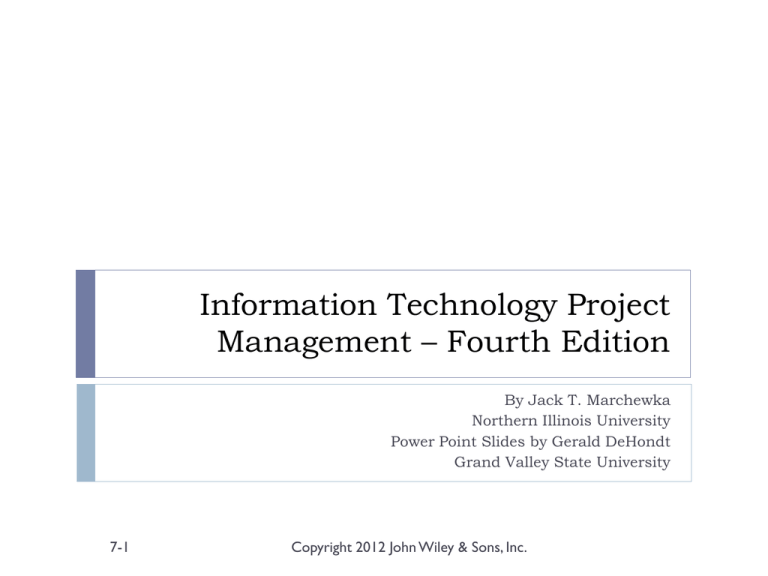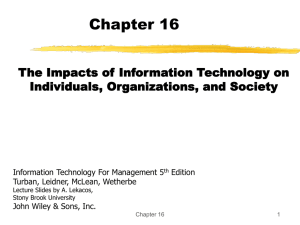
Information Technology Project
Management – Fourth Edition
By Jack T. Marchewka
Northern Illinois University
Power Point Slides by Gerald DeHondt
Grand Valley State University
7-1
Copyright 2012 John Wiley & Sons, Inc.
The Project Schedule and Budget
Chapter 7
7-2
Copyright 2012 John Wiley & Sons, Inc.
Learning Objectives
Describe the Project Management Body of Knowledge (PMBOK®) area
called project cost management.
Develop a Gantt chart.
Develop a project network diagram using the activity on the node (AON)
technique.
Identify a project’s critical path and explain why it must be controlled and
managed.
Develop a PERT diagram.
Describe the concept of precedence diagramming and identify finish-tostart, start-to-start, finish-to-finish, and start-to-finish activity relationships
Describe the concept of critical chain project management (CCPM)
Describe the various costs that make up the project’s budget.
Define what is meant by the baseline project plan.
7-3
Copyright 2012 John Wiley & Sons, Inc.
PMBOK® Project Cost Management
Estimate Costs
Determine Budget
Focuses on the processes to estimate the monetary resources
needed to complete the project work or activities.
Aggregating the individual cost for each of the project activities
or work package components to determine the cost baseline
or overall project budget.
Control Costs
7-4
Updating the project’s status while monitoring the project’s
budget and managing any changes to the baseline plan.
Copyright 2012 John Wiley & Sons, Inc.
The Project Planning Framework
7-5
Copyright 2012 John Wiley & Sons, Inc.
Budget and Schedule Development
The project’s schedule can be determined based upon the
tasks and time estimates in the WBS
The schedule will also depend on how these activities are
sequenced
The project’s budget can be determined based upon the
activities and time estimates from the WBS as well as the
cost of the resources assigned to the WBS tasks
Iterations may still be necessary
The objective is to create a realistic project schedule and
budget!
7-6
Copyright 2012 John Wiley & Sons, Inc.
Developing the Project Schedule
Project Management Tools
Gantt Charts
Project Network Diagrams
7-7
Activity on the Node (AON)
Critical Path Analysis
Program Evaluation and Review Technique (PERT)
Precedence Diagramming Method (PDM)
Copyright 2012 John Wiley & Sons, Inc.
Gantt Chart for Planning
7-8
Copyright 2012 John Wiley & Sons, Inc.
Gantt Chart Reporting
Project’s Progress
7-9
Copyright 2012 John Wiley & Sons, Inc.
Activity Analysis for AON
Activity
7-10
Description
Estimated
Duration (Days)
Predecessor
A
Evaluate current technology
platform
2
None
B
Define user requirements
5
A
C
Design Web page layouts
4
B
D
Set-up Server
3
B
E
Estimate Web traffic
1
B
F
Test Web pages and links
4
C,D
G
Move web pages to
production environment
3
D,E
H
Write announcement of
intranet for corp. newsletter
2
F,G
I
Train users
5
G
J
Write report to management
1
H,I
Copyright 2012 John Wiley & Sons, Inc.
Activity on the Node (AON)
Network Diagram
7-11
Copyright 2012 John Wiley & Sons, Inc.
Possible Activity Paths
Possible Paths
Path
Path 1
A+B+C+F+H+J
Path 2
Path 3
Path 4
Path 5
7-12
2+5+4+4+2+1
A+B+D+F+H+J
2+5+3+4+2+1
A+B+D+G+H+J
2+5+3+3+2+1
A+B+D+G+I+J
2+5+3+3+5+1
A+B+E+G+I+J
2+5+1+3+5+1
Copyright 2012 John Wiley & Sons, Inc.
Total
18
17
16
19*
17
* The
Critical
Path
Critical Path
Longest path
Shortest time project can be completed
Zero slack (or float)
The amount of time an activity can be delayed before it delays the
project
Must be monitored and managed!
7-13
Project manager can expedite or crash by adding resources
Fast tracking – running activities in parallel which were
originally planned as sequential
The CP can change
Can have multiple CPs
Copyright 2012 John Wiley & Sons, Inc.
PERT
Program Evaluation and Review Technique
Developed in 1950s to help manage the Polaris
Submarine Project
Developed about the same time as the Critical Path
Method
Often combined as PERT/CPM
Employs both a project network diagram with a statistical
distribution
7-14
Copyright 2012 John Wiley & Sons, Inc.
Activity Analysis for PERT
Activity
Predecessor
Optimistic
Estimates
(Days)
Most Likely
Estimates
(Days)
Pessimistic
Estimates
(Days)
Expected
Duration
(a+4b+c)
6
A
None
1
2
4
2.2
B
A
3
5
8
5.2
C
B
2
4
5
3.8
D
B
2
3
6
3.3
E
B
1
1
1
1.0
F
C,D
2
4
6
4.0
G
D,E
2
3
4
3.0
H
F,G
1
2
5
2.3
I
G
4
5
9
5.5
J
H,I
.5
1
3
1.3
7-15
Copyright 2012 John Wiley & Sons, Inc.
Possible PERT Activity Paths
Possible Paths
Path
Total
Path 1
A+B+C+F+H+J
18.8
2.2+5.2+3.8+4.0+2.3+1.3
Path 2
A+B+D+F+H+J
18.3
2.2+5.2+3.3+4.0+2.3+1.3
Path 3
A+B+D+G+H+J
18.6
2.2+5.2+3.3+3.0+2.3+1.3
Path 4
A+B+D+G+I+J
20.5*
2.2+5.2+3.3+3.0+5.5+1.3
Path 5
A+B+E+G+I+J
18.2
2.2+5.2+1.0+3.0+5.5+1.3
* The Critical Path
7-16
Copyright 2012 John Wiley & Sons, Inc.
Precedence Diagramming Method - PDM
Based on 4 fundamental relationships
7-17
Finish-To-Start (FS)
Start-To-Start (SS)
Finish-To-Finish (FF)
Start-To-Finish (SF)
Copyright 2012 John Wiley & Sons, Inc.
PDM Relationships
7-18
Copyright 2012 John Wiley & Sons, Inc.
Lead and Lag times
Lead is starting the next task before the first task is
complete
Example: Begin installing the operating systems when half of the PCs
are set up
Lag (or negative lead) is the adding of a buffer of time
before the next task begins
7-19
Example: Once the walls have been painted, wait one day before laying
the carpet so that the walls have had a chance to dry
Copyright 2012 John Wiley & Sons, Inc.
Critical Chain Project Management (CCPM)
Introduced in 1997 in a book called Critical Chain by Eliyahu
Goldratt
Based on his previous work called the Theory of Constraints
CCPM is based on the idea that people often inflate or add cushioning
to their estimates to create a form of “safety” to compensate for
uncertainty or risk because …
Your work is dependent upon the work of someone else, and you
believe that starting your work will be delayed
Your pessimism from previous experience where things did not go as
planned
Your belief that the project sponsor or customer will cut your project
schedule or budget so you inflate your estimates to guard against
this cut
7-20
Copyright 2012 John Wiley & Sons, Inc.
If people build safety into their estimates,
then …
Why are projects still late?
Student’s Syndrome or procrastinating until the last minute
before starting to work on a task
Parkinson’s Law or the idea that work expands to fill the time
available
Multitasking of resources or “resource contention”
7-21
People will rarely report finishing something early because there is
little incentive to do so or because they may fear that management
will cut their estimates next time
A person is often assigned to more than one project or required to
attend meetings, training, etc. As a result, they can no longer devote
their time to tasks that are on the critical path
Copyright 2012 John Wiley & Sons, Inc.
CCPM Assumptions
Begins by asking each person or team working on a task to
provide an estimate that would have a 50% chance of being
completed as planned
About half of the project tasks will be completed on time, about half
won’t
Instead of adding safety to each task, put that safety in the
form of buffers where it is needed most
Feeding buffers
Resource buffers
Reduce resource contention
End of Project buffers
7-22
Reduce the likelihood of bottlenecks by ensuring that critical tasks will start
on time when a task acts as a feeder to another task on the critical path
Are equal to one-half of the time saved from putting safety into each task
Copyright 2012 John Wiley & Sons, Inc.
The Critical Chain Project Schedule
Project Schedule with Safety in Each Task
A
B
10 Days
10 Days
C
E
10 Days
10 Days
D
10 Days
Critical Chain Project Schedule
A
B
C
E
5 Days
5 Days
5 Days
5 Days
D
10
Buffers
5 Days 2.5 Days
7-23
Copyright 2012 John Wiley & Sons, Inc.
Critical Chain Project Management
And the critical path are similar
Takes a more project portfolio view
Other projects should be scheduled so that a resource can be dedicated to a
particular task
Requires that everyone understand that each project task has a 50% chance
of being completed as scheduled, so about half of the tasks will be late.
The difference is the CCPM takes into account resource contention
This is the reason for having the project buffer.
Instead of tracking each task individually, we become more concerned with the
project buffer –i.e., the project will be late only if it uses more than the allotted
project buffer.
Instead of penalties for being late, bonuses or other incentives for
completing tasks early may be needed
7-24
Copyright 2012 John Wiley & Sons, Inc.
Developing the Project Budget
1.
2.
3.
4.
5.
7-25
Define what resources will be needed to perform
the work
Determine the quantity of resources that are
needed
Define the cost of using each resource
Calculate the cost of the task or activity
Ensure that the resources are leveled, that is,
resources have not been over allocated, assigned to
more than one task scheduled at the same time
Copyright 2012 John Wiley & Sons, Inc.
Project Management Software Tools
A number of project management software tools are
available to plan and track the progress of your project
However, having a fundamental understanding of these
project management techniques is important to make the
most of these software tools
7-26
Copyright 2012 John Wiley & Sons, Inc.
Other Costs
Direct Costs
Indirect Costs
Often have to “Build one and throw it away” to understand a problem
or a new technology
Prorated Costs
Costs incurred prior to the project, such as a project that has been
restarted after a failed attempt
Learning Curve
The cost for covering such things as rent, utilities, insurance, etc.
Sunk Costs
The direct cost of labor or other resources
The idea that there is a cost associated with using a resource
Reserves
7-27
Contingency funds to be used at the discretion of the project manager
Copyright 2012 John Wiley & Sons, Inc.
Finalizing the Project Schedule and
Budget
The project schedule and budget may require several
iterations before it is acceptable to the sponsor, the
project manager, and the project team.
Once the project schedule and project plan are accepted,
the project plan becomes the baseline plan.
Once accepted, the project manager and project team
have the authority to execute or carry out the plan.
7-28
Copyright 2012 John Wiley & Sons, Inc.
MS Project®
Working with MS Project ® DEMO
NOTE TO INSTRUCTORS: This is a good place
to introduce MS Project ® or another project software
package
7-29
Copyright 2012 John Wiley & Sons, Inc.
Free MS Project ® Tutorials
http://www.profsr.com/msproject/msproj01.htm
http://office.microsoft.com/enus/training/FX100565001033.aspx
http://www.project-blog.com/
7-30
Copyright 2012 John Wiley & Sons, Inc.
Copyright 2012 John Wiley & Sons, Inc.
All rights reserved. Reproduction or translation of this work beyond that
permitted in section 117 of the 1976 United States Copyright Act without
express permission of the copyright owner is unlawful. Request for further
information should be addressed to the Permissions Department, John
Wiley & Sons, Inc. The purchaser may make back-up copies for his/her own
use only and not for distribution or resale. The Publisher assumes no
responsibility for errors, omissions, or damages caused by the use of these
programs or from the use of the information herein.
7-31
Copyright 2012 John Wiley & Sons, Inc.




